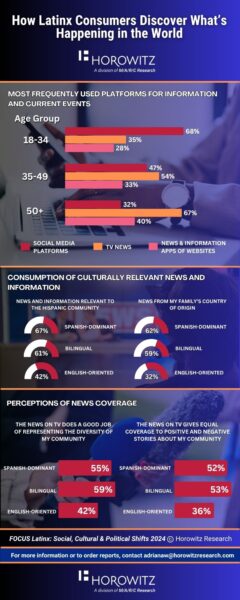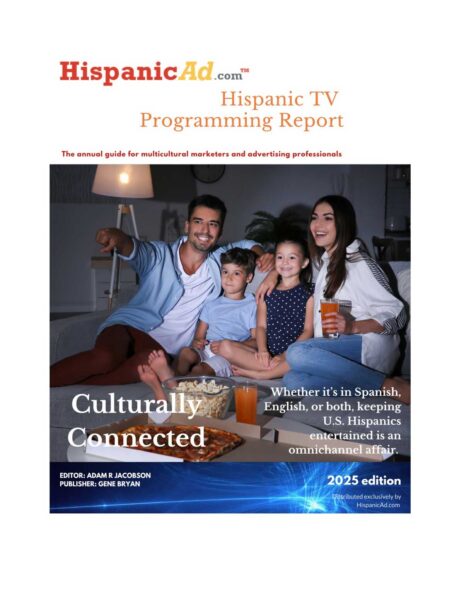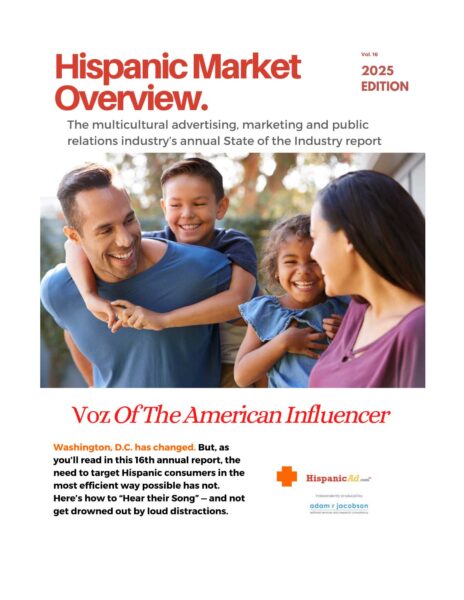How do Latinx consumers find out about what’s happening in the world?
June 12, 2025

Understanding where and how Latinx consumers get their news is important for brands and organizations looking to connect meaningfully with this influential and diverse audience.
Horowitz Research’s latest study, FOCUS Latinx: Social, Cultural & Political Shifts 2024, confirms something many of us, myself included, have experienced firsthand: Younger Latinx are turning to social media for their news (68% of 18-34-year-olds), while older generations still rely on TV news. But here’s what’s surprising: TV news isn’t out of the picture for young Hispanics. In fact, 1 out of 3 Latinx in my age group (18-34) are still tuning into TV news for current events.
Why does this matter? It shows there’s a real, existing market for younger viewers already engaging in TV news (on any platform). It’s not about convincing them to come back but, rather, about building on the foundation that’s already there. TV news isn’t “dead on arrival” like many brands and organizations assume. 35% of younger Latinx are already paying attention, but what are you doing to serve them? And more importantly, how can you further develop that connection?
 Platform choice is only one part of the story, however. Understanding content relevance and trust is key. According to the study, 67% of Spanish-dominant and 61% of bilingual Latinx prioritize news that’s relevant to the Latinx community. This might be even more critical nowadays, given the sense of vulnerability many in the Latinx community are feeling. And for many that also means staying connected to their roots and what’s happening to their people “back home”, with 62% of Spanish-dominant Latinx seeking out news from their family’s country of origin. These are active audiences looking for coverage that reflects who they are and where they come from.
Platform choice is only one part of the story, however. Understanding content relevance and trust is key. According to the study, 67% of Spanish-dominant and 61% of bilingual Latinx prioritize news that’s relevant to the Latinx community. This might be even more critical nowadays, given the sense of vulnerability many in the Latinx community are feeling. And for many that also means staying connected to their roots and what’s happening to their people “back home”, with 62% of Spanish-dominant Latinx seeking out news from their family’s country of origin. These are active audiences looking for coverage that reflects who they are and where they come from.
However, the study also found that perceptions of how the news covers the Hispanic community is uneven among Latinx. While nearly 6 in 10 bilingual Latinos say the news does a good job representing their community, that drops to just 41% among English-oriented Latinx. Even fewer English-oriented (36%) believe the coverage is balanced between positive and negative stories. For English-oriented Latinx, the disconnect may lie in coverage that feels one-dimensional, heavily focused on the Latinx immigrant population and less on issues that are impacting U.S.-born Latinx. Media and brands have the opportunity to bridge this gap by reflecting the community’s full diversity and lived experiences.
ABOUT THE AUTHOR
Sarah Garnica is a Marketing Associate at Horowitz Research, driven by her passion for understanding market trends. She thrives on connecting brands with consumers and is dedicated to giving voices to those who are often overlooked, ensuring diverse perspectives are heard and valued.





























